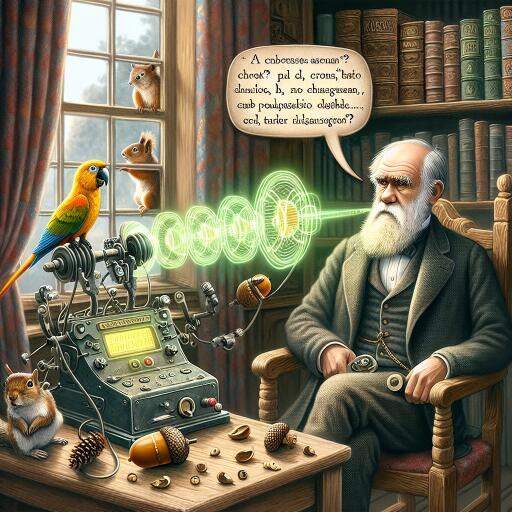Charles Darwin’s Vision Comes to Life: Translating Animal Speech with Groundbreaking Technology
In an era where the boundaries of science fiction and scientific breakthroughs are continuously blurred, a groundbreaking innovation has emerged, turning a two-century-old prediction by Charles Darwin into reality. Contrary to skeptics of the past, a notable discovery has now proved Darwin right: animals do communicate in intricate ways, and for the first time in history, technology has allowed us to understand them. The implications of this discovery have sent ripples of amazement throughout the globe, unveiling the potential of a new era in human-animal communication as we venture deeper into 2024.
The cornerstone of this revolutionary breakthrough was laid by an unconventional project led by the E2O Foundation, known as Project CETI. This initiative, aided by the latest advancements in artificial intelligence (AI), has achieved what was once deemed impossible: translating the complex language of sperm whales into a decipherable format for humans. The findings, which were recently published in the prestigious Nature Communication journal, highlight a complex system of clicks and codas previously underestimated in their communicative potential.
By analyzing close to 9,000 codas from the Eastern Caribbean sperm whale populations, the research team uncovered an intricate blend of rhythms, tempos, and musical elements in the whales’ communication methods. Dr. Daniela Rus, from MIT’s Computer Science and Artificial Intelligence Laboratory, explained, “Our findings reveal that these coda types are not random but are part of a sophisticated combinatorial coding system. By integrating musical concepts such as rubato and ornamentation with rhythm and tempo, we’ve uncovered a unique form of communication that resembles the complexity of human language.”
The study further demonstrates how sperm whales are capable of adjusting their “speech” in real-time, adding nuanced clicks to their codas based on the context of the conversation. Such versatility and adaptability are hallmarks of human language, making this discovery even more profound. It suggests that despite significant genetic, morphological, and cultural differences, sperm whales share a commonality with humans in their capacity for complex acoustic language.
This monumental leap in understanding was made possible through the sophisticated application of AI and machine learning techniques. Researchers at CETI meticulously recorded and analyzed the whales’ codas, applying AI algorithms to unravel the meaning behind these enigmatic sounds. The outcome? A groundbreaking “alphabet” for sperm whale language, providing us with the closest approximation to understanding their conversations.
The revelation that animals, particularly sperm whales, have a complex system of communication opens up new avenues for research and fosters a deeper appreciation for the cognitive abilities of wildlife. While the decoded phonetics may not convey the full depth of the whales’ conversations, this pioneering study offers a glimpse into their world, bridging the gap between human and animal communication.
As we stand on the brink of this new frontier, the potential for further discoveries looms large. What we’ve unearthed is merely the tip of the iceberg in unraveling the mysteries of animal communication. With continued advancements in technology and a deeper understanding of the animal kingdom, the future promises even more remarkable insights into the minds and languages of the Earth’s diverse inhabitants.
The journey of decoding animal speech is just beginning, and the implications of such a capability are vast. From enhancing our conservation efforts to fostering a more profound connection with the natural world, the translation of animal languages could redefine our relationship with Earth’s many species. Darwin’s foresight into the complexities of animal communication has not only been validated but has also opened the door to a fascinating new realm of scientific inquiry and exploration.
In reflecting upon this monumental achievement, one can’t help but wonder what other secrets lie hidden within the vocalizations of the animal kingdom. As technology continues to evolve and our understanding deepens, the future of human-animal communication holds limitless possibilities, all waiting to be discovered.










